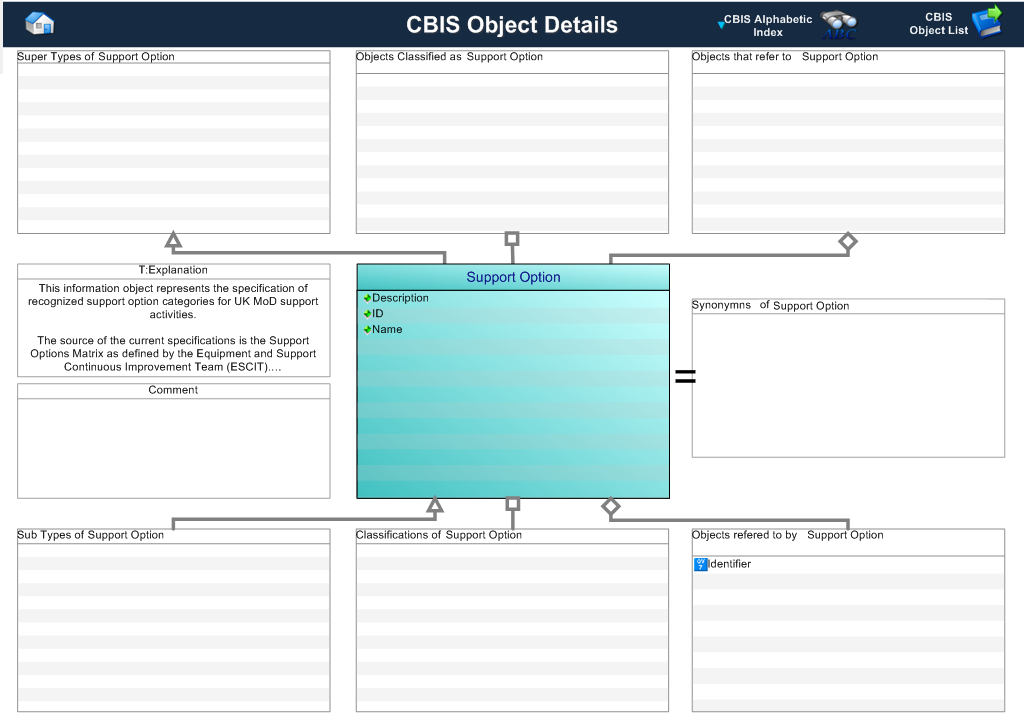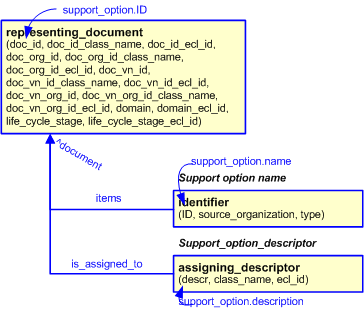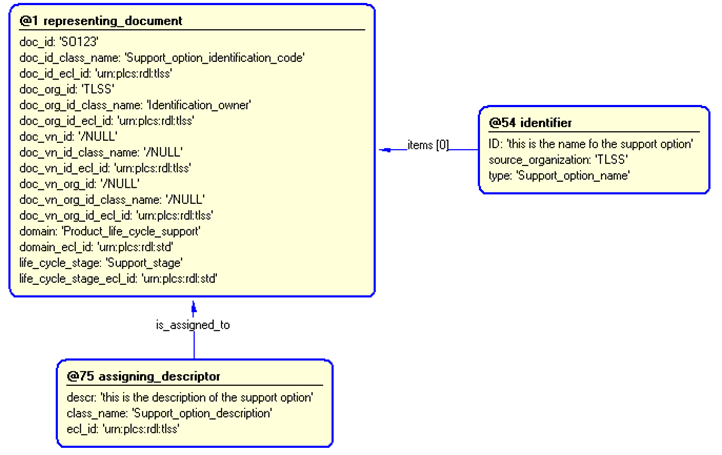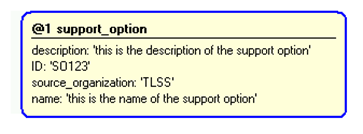Template:— support_option (supp_opt)
Context:— UK_Defence |
Date: 2009/04/17 11:58:03
Revision: 1.4
|
This section specifies the template support_option.
NOTE
The template has been defined in the context of
UK_Defence.
Refer to the business context for details of related templates.
NOTE
An explanation of a template and the associated instantiation path is
provided in the
Template overview
section.
This template describes how to represent the specification of recognized support option
categories for UK MoD support activities. The source of the current specifications is the
Support Options Matrix as defined by the Equipment and Support Continuous Improvement
Team (ESCIT). Other categories may be more appropriate for other support components
The support option business object is used by those UK_Defence Data Exchange
Specifications that require information about the specification of recognized support option
categories for UK MoD support activities.
Figure 1 — Graphical Representation for Business Object Support Option
Support Option:
The definition of a Support Option object is:
Data about the specification of recognized support option
|
Attribute name
|
Attribute description
|
Attribute type
|
Optionality
|
| Description |
This is the description of the support option. |
Intrinsic |
Mandatory |
| ID |
This is the Identifier of the support option. |
Identifier |
Mandatory |
| Name |
This is the name of the support option.
The 8 current options are:
"Spares exclusive upkeep";
"Spares inclusive upkeep";
"Incentivised upkeep cost reduction";
"Incentivized reliabilty improvement";
"Asset availability service (on balance sheet)";
"Asset availability service (off balance sheet)";
"Capability service (on balance sheet)";
"Capability service (off balance sheet)"
|
Intrinsic |
Mandatory |
Table 1 — Support Option attribute details
The EXPRESS-G diagram in
Figure
2
shows the templates and EXPRESS entities that are required
to represent the template
"support_option".
The text highlighted in blue shows the template parameters.
Figure 2 — An EXPRESS-G representation of the Information model for support_option
The graphic for the template to be used in other EXPRESS-G diagrams
is shown in Figure
3
below.
Figure 3 — The graphical representation of the support_option template
The following input parameters are defined for this template:
This is the description of the support option.
This is the identifier of the support option.
The organization that created the associated identifier. Additionally
a Person or Information System could be defined when either of these are the source; see Identifier template.
This is the name of the support option.
The following reference parameters are defined for this template:
Allow the
Document
entity instantiated in this path to be referenced when this template is used.
Note: The
Document
entity can be referenced in a template path by:
%^target = $support_option.supp_opt%
where
target
is the parameter to which the
Document
is bound.
The following parameter combinations specify a uniqueness constraint:
Unique constraint: Support_option
Each instance of the
entity
(
Document)
within the data set shall be uniquely identified
by a combination of the following parameters on this
template (support_option) namely:
ID,
name.
The
instance is
referenced by the following template parameter:
supp_opt.
The instantiation path shown below specifies the entities that are to be
instantiated by the template.
A description of templates and the syntax for the instantiation path is
provided in the
Templates Help/Information section.
-- Instantiate a document /
representing_document(
doc_id=@ID,
doc_id_class_name='Support_option_identification_code',
doc_id_ecl_id='urn:plcs:rdl:uk_defence',
doc_org_id=@source_organization,
doc_org_id_class_name='Identifier_owner',
doc_org_id_ecl_id='urn:plcs:rdl:uk_defence',
doc_vn_id='/NULL',
doc_vn_id_class_name='/NULL',
doc_vn_id_ecl_id='urn:plcs:rdl:uk_defence',
doc_vn_org_id='/NULL',
doc_vn_org_id_class_name='/NULL',
doc_vn_org_id_ecl_id='urn:plcs:rdl:uk_defence',
domain='Product_life_cycle_support',
domain_ecl_id='urn:plcs:rdl:std',
life_cycle_stage='Support_stage',
life_cycle_stage_ecl_id='urn:plcs:rdl:std')/
%^supp_opt = $representing_document.document%
-- Name (mandatory) /
identifier(
ID=@name,
source_organization=@source_organization,
type='Support_option_name',
items=^supp_opt)/
-- Instantiate a description /
assigning_descriptor(
descr=@description,
class_name='Support_option_description',
ecl_id='urn:plcs:rdl:uk_defence',
is_assigned_to=^supp_opt)/
The instance diagram in Figure
4
shows an example of the EXPRESS entities and templates that are instantiated by the template:
/support_option(name='this is the name of the support option', ID='SO123', source_organization='UK_Defence', description='this is the description of the support option')/
(an illustration of the consolidated support_option template is shown in
Figure
5 below.)
Figure 4 — Entities instantiated by support_option template
The instance diagram in
Figure
5
shows the graphic symbol for the template that is to be
used in other instance diagrams. The example template is:
/support_option(name='this is the name of the support option', ID='SO123', source_organization='UK_Defence', description='this is the description of the support option')/
Figure 5 — Instantiation of support_option template
Characterizations
No common characterizations of the template
support_option
have been identified. However, the ISO 10303-239 EXPRESS model
may enable other assignments to the entities instantiated by the template.




